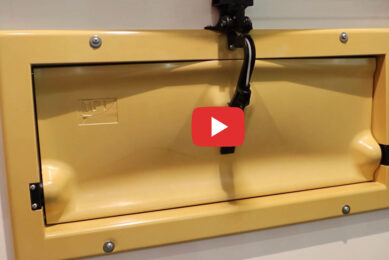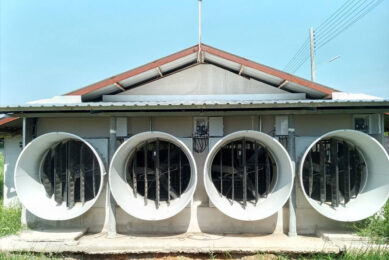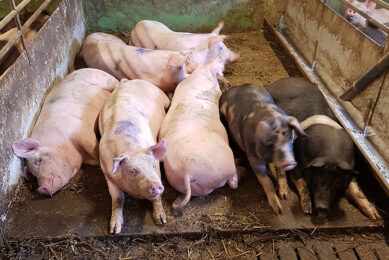Natural ventilation

There are still a few producers who ventilate their piggeries without the assistance of power. These notes may help them get the process as efficient as nature permits.
Natural ventilation moves air both through adjustable and fixed openings. ‘Adjustable’ includes windows, eave panels, ridge openings and ventilated doors. ‘Fixed’ openings use open points in the building, especially continuous ridge and eave gaps as well as lattice sides to big courts.
Natural vs mechanical ventilation – a dramatic trial
While manually operated natural ventilation is much cheaper than mechanical ventilation, manually altering such systems is never frequent enough, so cannot match that of mechanical control. Many years ago I was able to record some figures from a client’s unit as he changed from a natural manually-operated system to a modern fan installation with a control correctly operated by a sensor. We had four weeks to measure temperatures both inside and out, in two adjacent barns with pigs of similar weights when both systems were running concurrently. The averaged results on a weekly basis, as Table 1 shows, were clear and dramatic.
Table 1
Naturally we followed both barns to slaughter to see if just one month’s comparison made much of a difference, and even for this short winter period – it did.
In the 24 hours the naturally-ventilated pigs remained too cold much longer, despite diligent morning and evening adjustment of the exit flaps.
How to calculate naturally-ventilated openings?
Outlet air
- Calculate total liveweight of pigs (in kg) at maximum intended stocking rate;
- Allow 230 cm2 opening per 100 kg;
- This gives the total exhaust air opening required;
- Divide the total occupancy area into squares on the floor plan – in the example in Figure 1, divide into four;
- Insert insulated (important) ventilator trunks at the centre of each square;
- Exit ventilator trunks should be insulated to a minimum ‘U’ value of 0.5. ‘U’ values of 0.4 in ceilings and 0.5 in side walls are advisable;
- Provide adjustable butterfly valves to close to 95%.
Inlet air
- Divide the total liveweight expected by 100;
- Allow 700 cm2 per 100 kg;
- Divide the floor plan into squares as before;
- Divide the number of squares into the total floor space;
- Place four equal-sized inlets on two sides of each square, see Figure 1;
- Provide hinged flaps that can close upwards to 95%, but which can also be dropped down completely in hot conditions outside;
- Inlets should open upwards to deflect incoming air towards the ceiling;
- A high ceiling is desirable, sloped up towards the exit ventilators;
- To avoid ‘wind shadow’, naturally-ventilated buildings up to 5 m high should be at least 15 m apart to allow uninterrupted inlet air flow;
- For every 0.5 m higher, allow 1 m more lateral space.
Figure 1
Note: Inlet and outlet allowances can vary from source to source, i.e. up on a ridge or down in a dip or sheltered spot. My figures are a compromise and have worked well in non-extreme conditions. If in doubt seek help from a ventilation expert – who sadly are rare birds these days.
[Source: Pig Progress magazine Vol 30 nr 4, 2014 – ‘What the textbooks don’t tell you about…’ series]











